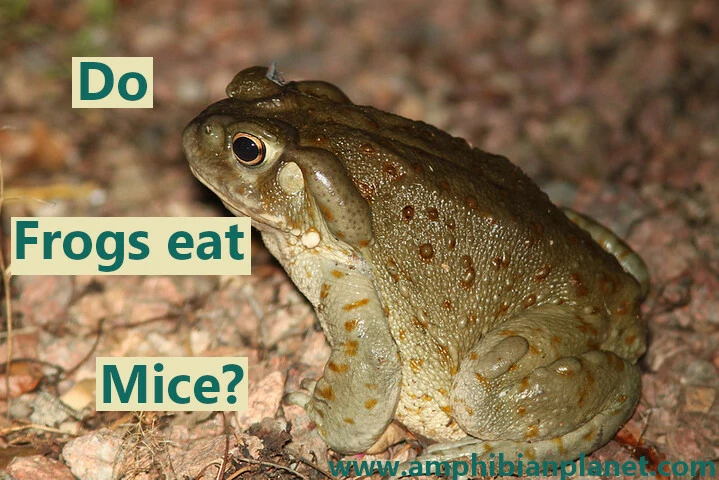Frogs are generalist carnivores that feast on worms, bugs, and a wide variety of other prey. They aren’t very picky with what they eat, so almost any prey they can catch and fit into their mouths is on the menu. In general, the bigger the frog, the bigger the prey it can eat.
Frogs eat mice that are small enough to fit into their mouths. Large species of frogs such as bullfrogs regularly eat newborn, juvenile, and even adult mice. Smaller frogs such as leopard frogs can eat newborn mice, but not fully-grown mice because they are too large for them to swallow.
Although frogs have teeth, they do not use the chew. Rather, they use them to maintain a tight grip on their prey as they swallow it whole. For this reason, they will only eat prey that is small enough to swallow whole.
Almost any small enough prey they can catch, and overpower, is on the menu, including venomous snakes!
Large Frogs Eat Smaller Mice
Frogs are opportunistic predators with very diverse diets. Smaller frogs mostly eat small worms and a wide variety of bugs, but large frogs such as bullfrogs will also eat smaller amphibians, small lizards, birds, and many other small animals.
If the prey is slow enough to catch and small enough to fit into the mouth, it is on the menu – and mice are not off limits.
That being said, it is important to note that most frogs do not frequently eat mice in the wild. They will prey on mice when the opportunity presents itself, but most of their diet will consist of worms and a wide variety of bugs.
Below is a table of frog species that are known to eat mice:
Frog Species |
Do They Eat Newborn Mice? |
Do They Eat Juvenile Mice? |
Do They Eat Adult Mice? |
| American bullfrog | Yes | Yes | Yes |
| African bullfrog | Yes | Yes | Yes |
| East Asian bullfrog | Yes | Yes | Yes |
| African clawed frog | Yes | Yes | No |
| Green frog | Yes | Yes | No |
| Bronze frog | Yes | Yes | No |
| Australian green tree frog | Yes | Yes | No |
| Leopard frog | Yes | No | No |
| Pickerel frog | Yes | No | No |
| South American horned frogs (Pacman frogs) | Yes | Yes | Yes |
| Smoky jungle frog | Yes | Yes | Yes |
| Cane toad | Yes | Yes | Yes |
| Colorado River toad | Yes | Yes | Yes |
| American toad | Yes | No | No |
| Fowler’s toad | Yes | No | No |
| Goliath frog | Yes | Yes | Yes |
| Tomato frog | Yes | No | No |
Smaller frog species such as Gray tree frogs, or American green tree frogs do not eat mice because they are not large enough to overpower or swallow them. Instead, they eat ants, beetles, and other invertebrates.
One study at the University of Missouri examined the stomach contents of gray tree frogs in central Missouri and found that ants and beetles were 70.8% of their diet.
Bullfrogs Eat Mice
Bullfrogs will eat almost anything that passes in front of them – as long as they can fit it into their mouths. They will eat scorpions, spiders, rodents, bats, fish, birds, lizards, and even each other! (yes, they can be cannibals).
If a mouse passes in front of a hungry bullfrog, the frog will try to eat it.

Bullfrogs are generally very aggressive and will often bite and eat prey that is too large for them. Large bullfrogs are even known to eat adult mice.
Pacman Frogs Eat mice
Pacman frogs (South American horned frogs) grow to a length of six inches and are about as wide as they are long. They have very large mouths, enabling them to large prey such as adult mice.
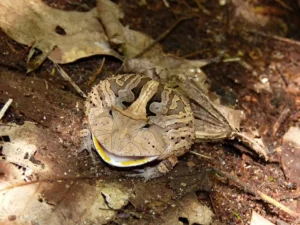
Australian Green Tree Frogs Eat Mice
Australian green tree frogs (also called the ‘White’s tree frogs’) are fairly small, only growing to a maximum length of 4.5 inches as adults. But this does not stop them from eating mice, and even snakes when they get the chance.

Due to their small size, they mainly eat baby mice or young mice that are still small enough for them to easily swallow.
Female Australian green frogs are larger than males, so they can eat larger mice than the latter.
Goliath Frogs Can Eat Mice
Goliath frogs are found in coastal, Equatorial Guinea and Cameroon in West Africa. They are the largest frogs in the world, and can grow to over 8 inches in length and weigh over 7 pounds!

Goliath frogs have flattened, wide bodies with triangular heads and very wide mouths. Because of their size, they have no problem eating small birds, fish, snakes, and large mice.
Smoky Jungle Frogs Eat Mice
Smoky jungle frogs are found in much of Central and South America, within forested areas and wetlands. Females of this species grow to 6.9, but male frogs can grow over inches in length.
They have large heads and wide mouths and will eat just about anything they can overpower and swallow.
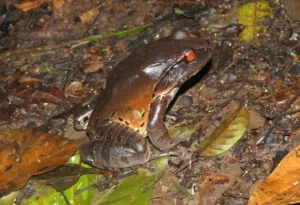
Apart from mice, smoky jungle frogs eat birds, snakes, lizards, smaller frogs, and bats. They are also one of the few frog species known to eat scorpions.
Cane Toads Eat Mice
Cane toads (also called marine toads) are native to South and Central America. But they have also been introduced to other countries where they aren’t native, such as Australia, where they have become a significant pest species.
They are also found in areas of Central and South Florida, including Key West and Stock Island, and in an isolated population in Bay County in the panhandle.
Cane toads are the largest toads in the world. They typically grow about 4 -6 inches in length, but can grow to over 9 inches in length and weigh over one pound!
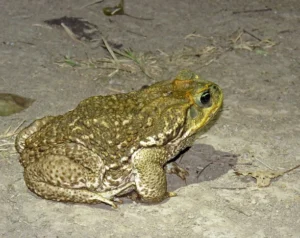
This large size allows them to eat large prey such as bats, rodents, birds, and small reptiles. They have also been documented eating plants, household refuse, and even dog and cat food.
Unlike most frogs that find their prey by movement, cane toads primarily use vision to find prey, and can also use their sense of smell to find food, such as dog food left outdoors.
American Toads Eat Mice
American toads are toads found throughout the eastern United States and Canada. These toads only grow to about 3.5 inches in length. However, they are very aggressive predators and will eat baby mice they can catch.
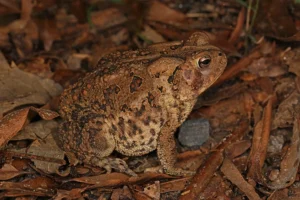
They also eat snails, slugs, beetles, worms, and a wide of other prey. Unlike most toads who sit and wait for prey to come closer so they can pounce on it, American toads can shoot out their tounges to catch prey.
When eating particularly large prey, they use their front legs to grasp it and push it into their mouths.
Northern Leopard Frogs Eat Mice
Leopard frogs are found in parts of the United States, and Canada. They grow to about 4.3 inches in length, with females being larger than males.
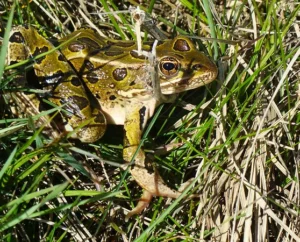
Leopard frogs mainly eat invertebrates, such as insects, spiders, slugs, snails, and worms. However, large adults also eat other frogs, small mice, and even small snakes.
Do Frogs Eat Dead Mice?
Frogs are instinctively attracted to movement while hunting for food. For this reason, most frogs will ignore dead mice.
Many insects use playing dead as a way to avoid predators, including frogs. Some insects stop moving and stay perfectly still to prevent frogs from eating them.
However, toads such as the Cane toad, which are known to eat carrion (dead animals), will readily eat dead mice they can find.
How Do Frogs Eat Mice?
Frogs catch and eat mice the same way they eat other prey They have sticky tongues that allow them to catch any moving insect that comes into range quickly.
Once a frog spots a small enough mouse, it launches its tongue to catch the prey. After catching the prey, the tongue wraps around it and coats it with sticky saliva. The frog will then yank its tongue back with a force equal to twelve times greater than the force of gravity.
Once the prey is in the mouth, the frog will swallow it whole (although frogs have teeth, they do not use them to chew, but rather to maintain a grip on their prey as they swallow it whole).
A frog can shoot out its tongue, capture prey and pull it back into its mouth within 07 seconds; which is five times faster than the human eye can blink. This speed makes it effective at catching even fast-flying insects such as flies.
Frogs that eat larger mice usually can not capture them using only their tongue, so instead, they lunge at them and bite down to maintain a firm grip.
They then use their front legs to grasp and push the prey into their mouths.
Mice Can Eat Dead Frogs
Mice are very opportunistic feeders and will consume any type of food available. They can eat fruits, vegetables, grain, food scraps, dog food, and even dead animals.
Sometimes, they will cannibalize other dead mice. They are also known to steal and eat bird eggs from nests.
Mice generally do not kill frogs to eat, but If a hungry mouse comes across a dead frog, it may try to eat it.
However, many species of rats (which are different from mice), are known to kill frogs and toads, sometimes for food.
Frequently Asked Questions
Do bullfrogs eat mice?
Bullfrogs are generalist predators and will eat almost any prey they can overpower and swallow whole, including mice. If a mouse passes in front of a hungry bullfrog, the frog will bite and try to eat it.
Do toads eat mice?
Large toad species such as the Colorado River toad, and the cane toad regularly eat mice they can catch and swallow whole. Smaller toad species generally do not eat mice in the wild but will eat baby mice when available
Do frogs eat rats?
Rats are typically larger than mice, so adult rats will be too big for most frogs to eat. However, large frog species such as bullfrogs, can eat young rats, and even some adult rats that are small enough.

